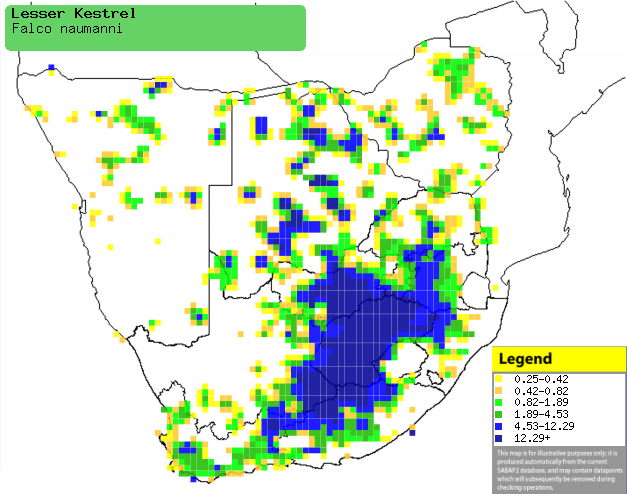|
Falco naumanni (Lesser
kestrel)
Kleinrooivalk [Afrikaans]; Kakodi (generic term for
sparrowhawks, goshawks, kestrels and falcons) [Kwangali]; Seotsanyana (applied
also to other kestrel species and to Amur falcon) [South Sotho]; Kleine
torenvalk [Dutch]; Faucon crécerellette [French]; Rötelfalke [German];
Peneireiro-das-torres [Portuguese]
Life
> Eukaryotes >
Opisthokonta
> Metazoa (animals) >
Bilateria >
Deuterostomia > Chordata >
Craniata > Vertebrata (vertebrates) > Gnathostomata (jawed
vertebrates) > Teleostomi (teleost fish) > Osteichthyes (bony fish) > Class:
Sarcopterygii (lobe-finned
fish) > Stegocephalia (terrestrial
vertebrates) > Tetrapoda
(four-legged vertebrates) > Reptiliomorpha > Amniota >
Reptilia (reptiles) >
Romeriida > Diapsida > Archosauromorpha > Archosauria >
Dinosauria
(dinosaurs) > Saurischia > Theropoda (bipedal predatory dinosaurs) >
Coelurosauria > Maniraptora > Aves
(birds) > Order: Falconiformes >
Family: Falconidae
Distribution and habitat
Breeds in eastern Europe, Asia Minor, Mongolia, Iran and
northern China, heading south in the non-breeding season to sub-Saharan Africa,
excluding the west African lowland forest. In southern Africa it is locally common in Zimbabwe, Botswana,
Namibia and South Africa (excluding much of the arid Karoo and east coast),
largely absent from Mozambique. It generally prefers warm, dry and open
habitats while largely avoiding disturbed areas, although it sometimes occupies
cultivated land.
|
 |
|
Distribution of Lesser kestrel in southern Africa,
based on statistical smoothing of the records from first SA Bird Atlas
Project (©
Animal Demography unit, University of
Cape Town; smoothing by Birgit Erni and Francesca Little). Colours range
from dark blue (most common) through to yellow (least common).
See here for the latest distribution
from the SABAP2. |
Movements and migrations
Palearctic breeding migrant, leaving its
breeding grounds from August-September and eventually arriving in
southern Africa in the period from October-November, leaving again
around March.
Food
It mainly eats arthropods, foraging from a perch or while
hovering above the ground. In the run up to its departure foraging activity
becomes more intense so that it can build up fat; for some reason the females
hunt more actively than the males during this time. The following food items
have been recorded in its diet:
Threats
Globally Vulnerable, as its total population has
decreased by at least 20% in the period from 1993-2003, and continues to do so.
This is thought to have been caused by habitat loss, disturbance by
agriculture, afforestation and urbanisation, as well as poisoning by pesticides
(especially those used against locust swarms), persecution and removal of trees
at roosting sites.
References
-
Hockey PAR, Dean WRJ and Ryan PG 2005. Roberts
- Birds of southern Africa, VIIth ed. The Trustees of the John Voelcker
Bird Book Fund, Cape Town.
|
